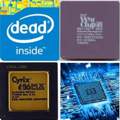NAS Zugriff verweigert?
Hallo, ich habe heute mit meinem Raspberry Pi einen Samba NAS eingerichtet nach folgender Anleitung:
https://www.youtube.com/watch?v=3Tn184NhMRI
Jetzt scheint alles zu funktionieren, nur nicht dass was es tun soll, denn ich kann leider nicht mit meinem angelegten Nutzer auf das NAS zugreifen.
"smb://raspberrry.local/192.168.178.45/ konnte nicht angezeigt werden"
"Fehler: Einhängen der Windows-Freigabe ist fehlgesschlagen:Datei oder Verzeichnis nicht gefunden. Bitte wählen sie einen anderen Betrachter und versuchen sie es erneut"
Wie kann ich das beheben?
Danke im Voraus
Betriebssystem Linux Mint
das ist meine smb.conf:
#
# Sample configuration file for the Samba suite for Debian GNU/Linux.
#
#
# This is the main Samba configuration file. You should read the
# smb.conf(5) manual page in order to understand the options listed
# here. Samba has a huge number of configurable options most of which
# are not shown in this example
#
# Some options that are often worth tuning have been included as
# commented-out examples in this file.
# - When such options are commented with ";", the proposed setting
# differs from the default Samba behaviour
# - When commented with "#", the proposed setting is the default
# behaviour of Samba but the option is considered important
# enough to be mentioned here
#
# NOTE: Whenever you modify this file you should run the command
# "testparm" to check that you have not made any basic syntactic
# errors.
#======================= Global Settings =======================
[global]
## Browsing/Identification ###
# Change this to the workgroup/NT-domain name your Samba server will part of
workgroup = WORKGROUP
#### Networking ####
# The specific set of interfaces / networks to bind to
# This can be either the interface name or an IP address/netmask;
# interface names are normally preferred
; interfaces = 127.0.0.0/8 eth0
# Only bind to the named interfaces and/or networks; you must use the
# 'interfaces' option above to use this.
# It is recommended that you enable this feature if your Samba machine is
# not protected by a firewall or is a firewall itself. However, this
# option cannot handle dynamic or non-broadcast interfaces correctly.
; bind interfaces only = yes
#### Debugging/Accounting ####
# This tells Samba to use a separate log file for each machine
# that connects
log file = /var/log/samba/log.%m
# Cap the size of the individual log files (in KiB).
max log size = 1000
# We want Samba to only log to /var/log/samba/log.{smbd,nmbd}.
# Append syslog@1 if you want important messages to be sent to syslog too.
logging = file
# Do something sensible when Samba crashes: mail the admin a backtrace
panic action = /usr/share/samba/panic-action %d
Der erste Teil, die Beschränkung der Zeichen liegt bei 3000 Zeichen, welche meine smb.conf übertrifft
6 Antworten

SMB ist für Windows(-Clients). Um von Linux zuzugreifen ist NFS performanter und simpler. Samba kann aber für Windows-Clients parallel laufen.
Und: hast du die Fehlermeldung hierher kopiert, oder versucht, sie abzutippen? Bei raspbeRRRy würde ich den Share auch nicht finden, wenn er nur mit RR geschrieben würde ;-) und ich gehe stark davon aus, dass du denn Hostnamen nicht mit drei R geschrieben hast.

Wie für nahezu alles unter Ubuntu und seinen „Abarten“ gibt es selbstverständlich Anleitungen. Wenn man es googelt ist eines der ersten Ergebnisse immer wiki.ubuntuusers.de

Aber ich kann leider auch nicht von Windows darauf zugreifen


Die smb.conf ist etwas groß, dauert noch ein paar Minuten, die Ausgabe der Befehle werde ich auch gleich posten

sudo service nmbd status
Ausgabe ist:
● nmbd.service - Samba NMB Daemon
Loaded: loaded (/lib/systemd/system/nmbd.service; enabled; vendor preset: enabled)
Active: active (running) since Tue 2020-04-21 19:18:02 BST; 4 days ago
Docs: man:nmbd(8)
man:samba(7)
man:smb.conf(5)
Main PID: 408 (nmbd)
Status: "nmbd: ready to serve connections..."
Tasks: 1 (limit: 2200)
Memory: 10.8M
CGroup: /system.slice/nmbd.service
└─408 /usr/sbin/nmbd --foreground --no-process-group
sudo service smbd status
Ausgabe ist:
● smbd.service - Samba SMB Daemon
Loaded: loaded (/lib/systemd/system/smbd.service; enabled; vendor preset: enabled)
Active: active (running) since Tue 2020-04-21 19:18:03 BST; 4 days ago
Docs: man:smbd(8)
man:samba(7)
man:smb.conf(5)
Main PID: 1159 (smbd)
Status: "smbd: ready to serve connections..."
Tasks: 4 (limit: 2200)
Memory: 13.2M
CGroup: /system.slice/smbd.service
├─1159 /usr/sbin/smbd --foreground --no-process-group
├─1204 /usr/sbin/smbd --foreground --no-process-group
├─1205 /usr/sbin/smbd --foreground --no-process-group
└─1207 /usr/sbin/smbd --foreground --no-process-group
hilft das irgendwie, danke nochmal

Gut, Dienste laufen. Aber deine smb.conf ist echt aufgeblasen. Speichere deine bestehende Config als Backup ab und erstelle eine neue Config. Versuch mal das hier und passe die einzelnen Angaben an.
##################
# GLOBALE CONFIG #
##################
[global]
workgroup = WORKGROUP
security = user
encrypt passwords = yes
usershare owner only = false
unix extensions = yes
#################
# Beispielheini #
#################
[Beispiel_Dokumente]
comment = Dokumente von Beispielheini
path = /media/NAS/Dokumente/Beispielheini
writable = yes
read only = no
guest ok = no
valid users = beispielheini
Ich habe https://wiki.ubuntuusers.de/Samba_Server/ als Anleitung für meine Konfiguration verwendet

Ich habe insgesamt sechs Ordner für zwei Nutzer. Ich habe mich dafür entschieden, jeden dieser Ordner einzeln freizugeben, also pro Ordner und Nutzer eine Freigabe. Damit stelle ich sicher, dass jeder Nutzer nur auf seine drei Ordner zugreifen darf.


Naja, ich habe, wie nachträglich geschrieben, insgesamt sechs verschiedene Ordner unterhalb von /media/NAS und die gebe ich einzeln, wie mit Beispielheini beschrieben frei, damit wiederholen sich die Einträge ein paar mal, außer dass die jeweiligen Ordner anders heißen. Aber ansonsten: Ja, mehr steht nicht drin.

#
# Sample configuration file for the Samba suite for Debian GNU/Linux.
#
#
# This is the main Samba configuration file. You should read the
# smb.conf(5) manual page in order to understand the options listed
# here. Samba has a huge number of configurable options most of which
# are not shown in this example
#
# Some options that are often worth tuning have been included as
# commented-out examples in this file.
# - When such options are commented with ";", the proposed setting
# differs from the default Samba behaviour
# - When commented with "#", the proposed setting is the default
# behaviour of Samba but the option is considered important
# enough to be mentioned here
#
# NOTE: Whenever you modify this file you should run the command
# "testparm" to check that you have not made any basic syntactic
# errors.
#======================= Global Settings =======================
[global]
## Browsing/Identification ###
# Change this to the workgroup/NT-domain name your Samba server will part of
workgroup = WORKGROUP
#### Networking ####
# The specific set of interfaces / networks to bind to
# This can be either the interface name or an IP address/netmask;
# interface names are normally preferred
; interfaces = 127.0.0.0/8 eth0
# Only bind to the named interfaces and/or networks; you must use the
# 'interfaces' option above to use this.
# It is recommended that you enable this feature if your Samba machine is
# not protected by a firewall or is a firewall itself. However, this
# option cannot handle dynamic or non-broadcast interfaces correctly.
; bind interfaces only = yes
#### Debugging/Accounting ####
# This tells Samba to use a separate log file for each machine
# that connects
log file = /var/log/samba/log.%m
# Cap the size of the individual log files (in KiB).
max log size = 1000
# We want Samba to only log to /var/log/samba/log.{smbd,nmbd}.
# Append syslog@1 if you want important messages to be sent to syslog too.
logging = file
# Do something sensible when Samba crashes: mail the admin a backtrace
panic action = /usr/share/samba/panic-action %d
####### Authentication #######
# Server role. Defines in which mode Samba will operate. Possible
# values are "standalone server", "member server", "classic primary
# domain controller", "classic backup domain controller", "active
# directory domain controller".
#
# Most people will want "standalone server" or "member server".
# Running as "active directory domain controller" will require first
# running "samba-tool domain provision" to wipe databases and create a
# new domain.
server role = standalone server
obey pam restrictions = yes
# This boolean parameter controls whether Samba attempts to sync the Unix
# password with the SMB password when the encrypted SMB password in the
# passdb is changed.
unix password sync = yes
# For Unix password sync to work on a Debian GNU/Linux system, the following
# parameters must be set (thanks to Ian Kahan <<kahan@informatik.tu-muenchen.de> for
# sending the correct chat script for the passwd program in Debian Sarge).
passwd program = /usr/bin/passwd %u
passwd chat = *Enter\snew\s*\spassword:* %n\n *Retype\snew\s*\spassword:* %n\n *password\supdated\ssuccessfully* .
# This boolean controls whether PAM will be used for password changes
# when requested by an SMB client instead of the program listed in
# 'passwd program'. The default is 'no'.
pam password change = yes
# This option controls how unsuccessful authentication attempts are mapped
# to anonymous connections
map to guest = bad user
########## Domains ###########
#
# The following settings only takes effect if 'server role = primary
# classic domain controller', 'server role = backup domain controller'
# or 'domain logons' is set
#
# It specifies the location of the user's
# profile directory from the client point of view) The following
# required a [profiles] share to be setup on the samba server (see
# below)
; logon path = \\%N\profiles\%U
# Another common choice is storing the profile in the user's home directory
# (this is Samba's default)
# logon path = \\%N\%U\profile
# The following setting only takes effect if 'domain logons' is set
# It specifies the location of a user's home directory (from the client
# point of view)
; logon drive = H:
# logon home = \\%N\%U
# The following setting only takes effect if 'domain logons' is set
# It specifies the script to run during logon. The script must be stored
# in the [netlogon] share
# NOTE: Must be store in 'DOS' file format convention
; logon script = logon.cmd
# This allows Unix users to be created on the domain controller via the SAMR
# RPC pipe. The example command creates a user account with a disabled Unix
# password; please adapt to your needs
; add user script = /usr/sbin/adduser --quiet --disabled-password --gecos "" %u
# This allows machine accounts to be created on the domain controller via the
# SAMR RPC pipe.
# The following assumes a "machines" group exists on the system
; add machine script = /usr/sbin/useradd -g machines -c "%u machine account" -d /var/lib/samba -s /bin/false %u
# This allows Unix groups to be created on the domain controller via the SAMR
# RPC pipe.
; add group script = /usr/sbin/addgroup --force-badname %g
############ Misc ############
# Using the following line enables you to customise your configuration
# on a per machine basis. The %m gets replaced with the netbios name
# of the machine that is connecting
; include = /home/samba/etc/smb.conf.%m
# Some defaults for winbind (make sure you're not using the ranges
# for something else.)
; idmap config * : backend = tdb
; idmap config * : range = 3000-7999
; idmap config YOURDOMAINHERE : backend = tdb
; idmap config YOURDOMAINHERE : range = 100000-999999
; template shell = /bin/bash
# Setup usershare options to enable non-root users to share folders
# with the net usershare command.
# Maximum number of usershare. 0 means that usershare is disabled.
# usershare max shares = 100
# Allow users who've been granted usershare privileges to create
# public shares, not just authenticated ones
usershare allow guests = yes
#======================= Share Definitions =======================
[homes]
comment = Home Directories
browseable = no
# By default, the home directories are exported read-only. Change the
# next parameter to 'no' if you want to be able to write to them.
read only = no
# File creation mask is set to 0700 for security reasons. If you want to
# create files with group=rw permissions, set next parameter to 0775.
create mask = 0700
# Directory creation mask is set to 0700 for security reasons. If you want to
# create dirs. with group=rw permissions, set next parameter to 0775.
directory mask = 0700
# By default, \\server\username shares can be connected to by anyone
# with access to the samba server.
# The following parameter makes sure that only "username" can connect
# to \\server\username
# This might need tweaking when using external authentication schemes
valid users = %S
# Un-comment the following and create the netlogon directory for Domain Logons
# (you need to configure Samba to act as a domain controller too.)
;[netlogon]
; comment = Network Logon Service
; path = /home/samba/netlogon
; guest ok = yes
; read only = yes
# Un-comment the following and create the profiles directory to store
# users profiles (see the "logon path" option above)
# (you need to configure Samba to act as a domain controller too.)
# The path below should be writable by all users so that their
# profile directory may be created the first time they log on
;[profiles]
; comment = Users profiles
; path = /home/samba/profiles
; guest ok = no
; browseable = no
; create mask = 0600
; directory mask = 0700
[printers]
comment = All Printers
browseable = no
path = /var/spool/samba
printable = yes
guest ok = no
read only = yes
create mask = 0700
# Windows clients look for this share name as a source of downloadable
# printer drivers
[print$]
comment = Printer Drivers
path = /var/lib/samba/printers
browseable = yes
read only = yes
guest ok = no
# Uncomment to allow remote administration of Windows print drivers.
# You may need to replace 'lpadmin' with the name of the group your
# admin users are members of.
# Please note that you also need to set appropriate Unix permissions
# to the drivers directory for these users to have write rights in it
; write list = root, @lpadmin
[Nas]
comment = Nas
path = /media/pi/externSpace/nas
valid users = @users
force group = users
create mask = 0660
directory mask = 0771
read only = no
Das ist die smb.conf
Ich konnte sie leider nicht mehr zur Frage hinzufügen, wegen der Begrenzung der Zeichen

raspberry.LACAL?


Falsche Syntax beim Verzeichnis. DNS im heimnetz ist nicht zuverlässig.
smb://192.168.x.x
Die beiden x bitte ersetzen so das die IP des pi daraus wird

ich kann leider trotzdem nicht darauf zugreifen, wenn ich den Benutzernamen und das Passwort eingebe und Enter drücke, dann taucht dsa selbe Feld nochmal auf und das ändert sich nicht


Ich habe meine smb.conf jetzt gepostet, als Kommentar, nicht als Ergänzung

Der Nutzer heißt echt @users? Könnte schon am Sonderzeichen liegen dass es Probleme gibt

Richtig wäre z.b beim ansprechen im Netz ... ( Windows 10 .. Netzlaufwerk verbinden oder Android )
\\NAS-PI\Public\Daten
Gilt nur als Beispiel.

Wie kann ich ihn dann richtig ansprechen(Dateimanager Kaja, Betriebssystem Linux Mint)




Wie soll ich das unter Katja machen, es hängt immer wieder denn vorherigen Pfad vorne dran
Ich kann leider aus irgendeinem Grund den Text in Fehlermeldungen von Kaja/LinuxMint nicht kopieren. Wie kann ich denn NFS einrichten, gibt es dafür auch Videos oder andere Anleitungen die du empfehlen kannst?